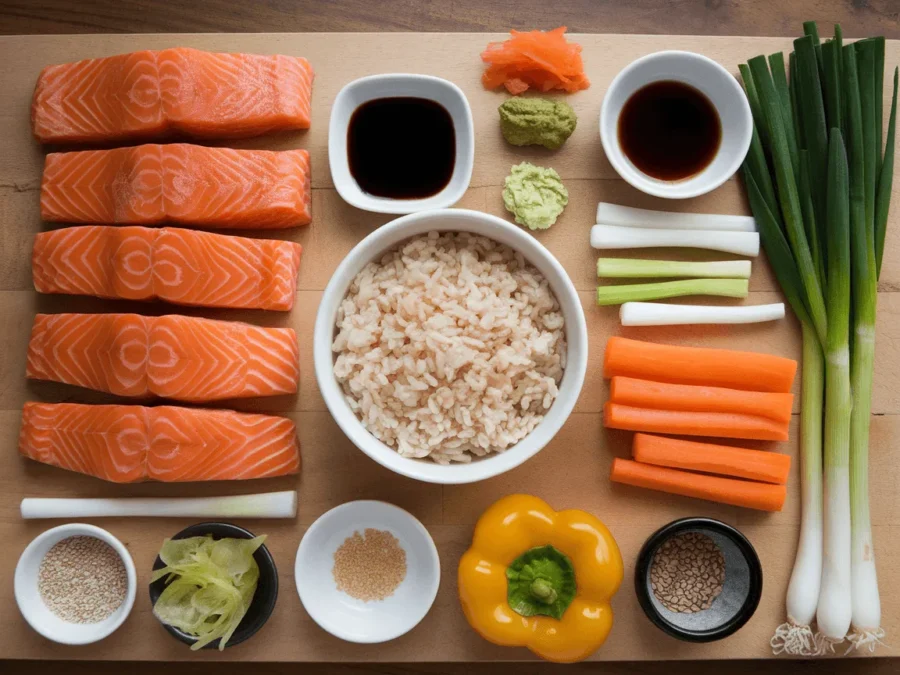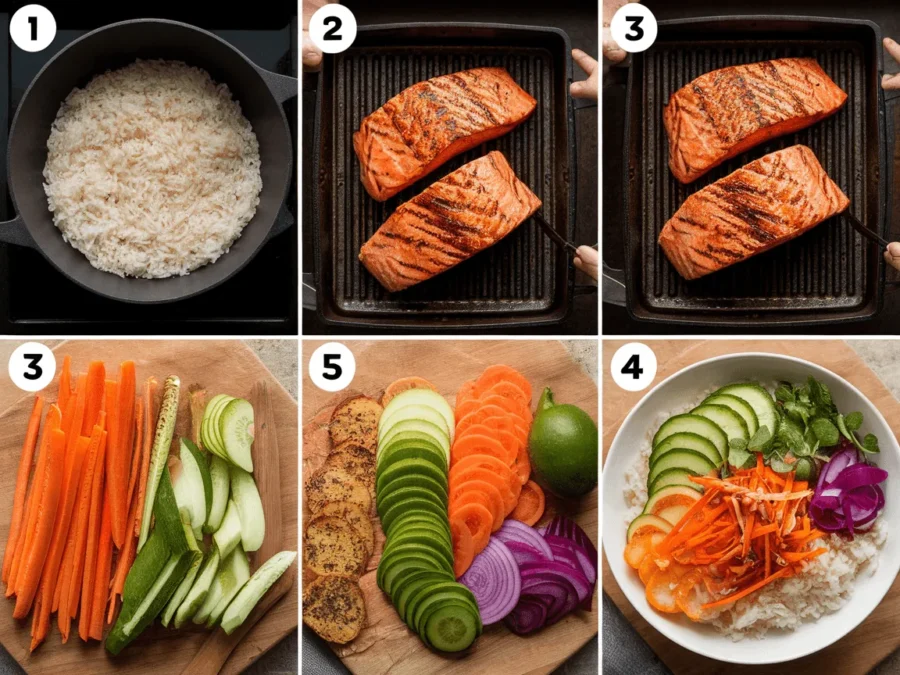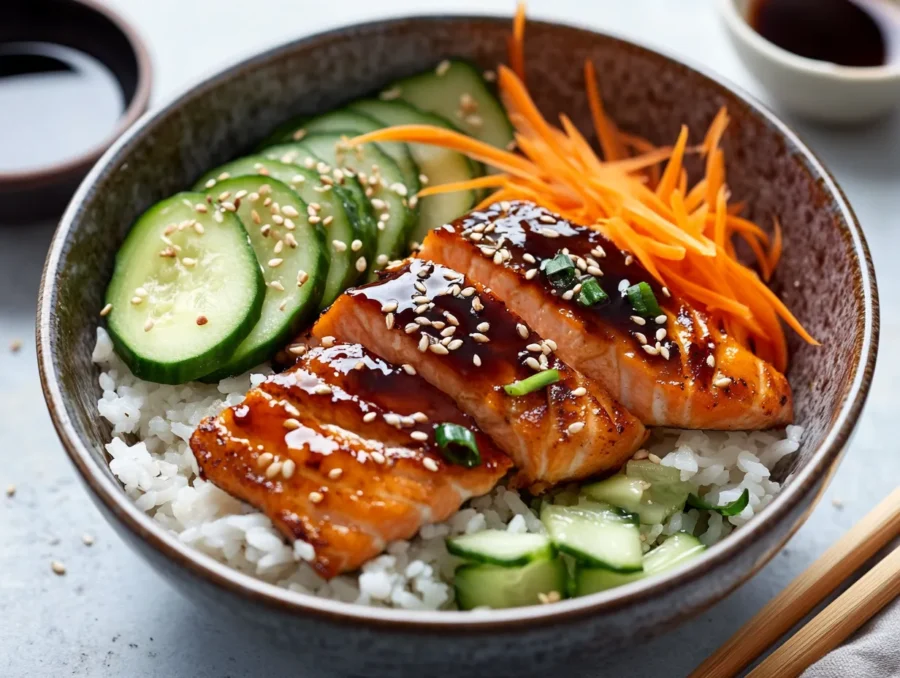In today’s busy world, finding a meal that’s both delicious and nutritious can be a challenge. Salmon rice bowls have become a go-to option for food enthusiasts because they strike the perfect balance between flavor, health, and simplicity. These bowls are a skillful canvas, letting you experiment with sauces, veggies, and spices to suit your palate.
This recipe is not just quick to prepare but also customizable, making it ideal for weekday dinners or meal preps. Let’s dive into the world of vibrant salmon rice bowls and discover why they should become a staple in your kitchen.
Table of Contents
Why Salmon Rice Bowls Are the Perfect Meal
Salmon rice bowls have become a favorite among food enthusiasts for good reasons. These bowls are not only visually appealing but also packed with nutrients and flavor. Here’s what makes them stand out:
A Nutritional Powerhouse
Salmon rice bowls combine three key components of a balanced diet: protein, carbohydrates, and vegetables.
- Salmon: Rich in omega-3 fatty acids, high-quality protein, and essential vitamins like B12 and D, salmon supports brain health, reduces inflammation, and promotes heart health.
- Rice: This grain provides the perfect base for the bowl. Choose options like brown rice for fiber or jasmine rice for a softer texture.
- Vegetables: Adding fresh or roasted vegetables enhances the dish with essential vitamins, antioxidants, and vibrant colors.
Quick and Customizable
One of the best things about salmon rice bowls is their flexibility. Whether you prefer spicy, sweet, or savory flavors, you can adapt the recipe to suit your tastes. Some popular variations include:
- Spicy Mayo Drizzle: For those who love heat, a sriracha-mayo combo can add the perfect kick.
- Teriyaki Glaze: A sweet and tangy teriyaki sauce can elevate your salmon rice bowl into a Japanese-inspired delight.
- Herb-Infused Citrus: Add lemon zest and dill for a refreshing twist.
Perfect for Any Meal
Salmon rice bowls are not just for dinner; they make an excellent choice for lunch or even meal prep. Prepare the components ahead of time and assemble your bowl whenever hunger strikes.
Eco-Friendly and Budget-Friendly
Salmon rice bowls can also be a sustainable and cost-effective option. By using responsibly sourced salmon and seasonal vegetables, you contribute to environmentally conscious eating. Moreover, the recipe uses basic pantry staples like rice and soy sauce, which makes it affordable to prepare.
Essential Ingredients for Your Salmon Rice Bowl
A perfect salmon rice bowl starts with carefully chosen ingredients. Each component plays a crucial role in delivering flavor, texture, and nutrition. Below is a detailed look at what you’ll need to make a mouthwatering salmon rice bowl.
The Core Ingredients
- Salmon Fillets
- Look for fresh or frozen salmon fillets with firm flesh and vibrant color. Wild-caught salmon is often more flavorful and nutrient-rich compared to farmed salmon.
- Pro Tip: Opt for skin-on fillets if you enjoy crispy salmon skin, which adds a delightful crunch to your bowl.
- Rice
- Base Options:
- White rice (like jasmine or sushi rice): Soft, sticky, and perfect for an Asian-inspired bowl.
- Brown rice: A healthier option, high in fiber and nuttier in flavor.
- Quinoa or cauliflower rice: Low-carb substitutes for a lighter bowl.
- Base Options:
- Vegetables
- Fresh or roasted veggies bring color, crunch, and vitamins to your bowl. Some popular choices include:
- Cucumber for crispness
- Avocado for creaminess
- Carrots and radishes for a hint of sweetness
- Broccoli or edamame for a protein boost
- Fresh or roasted veggies bring color, crunch, and vitamins to your bowl. Some popular choices include:
- Seasonings and Sauces
- The right seasoning and sauce elevate the flavor of the bowl. Include:
- Soy sauce or tamari (for gluten-free options)
- Sesame oil for nutty richness
- Spices like garlic powder, black pepper, and chili flakes
- Optional: Sriracha, teriyaki sauce, or a homemade spicy mayo
- The right seasoning and sauce elevate the flavor of the bowl. Include:
- Toppings
- Finish your bowl with a variety of garnishes to enhance texture and presentation:
- Toasted sesame seeds
- Freshly chopped scallions
- Nori sheets (seaweed) cut into strips
- Pickled ginger or sliced jalapeños for an extra kick
- Finish your bowl with a variety of garnishes to enhance texture and presentation:
Choosing the Best Ingredients
- How to Pick Fresh Salmon
- Smell: Fresh salmon has a clean, ocean-like aroma.
- Texture: The flesh should be firm and spring back when touched.
- Color: Look for vibrant, even coloring without dark spots.
- Selecting the Right Rice
- For a traditional bowl, short-grain rice works best as it’s sticky and holds sauces well. If you’re going for a lighter or gluten-free version, quinoa or wild rice is a great alternative.
- Sourcing Fresh Vegetables
- Visit a local farmer’s market for the freshest produce, or choose seasonal vegetables for the best flavor and cost savings.
Why These Ingredients Work Together
Each ingredient complements the others, creating a harmonious balance of flavors and textures:
- The salmon’s richness is offset by the light, fluffy rice and crisp vegetables.
- Sauces like soy or teriyaki bring umami depth, while toppings like sesame seeds add crunch and nutty notes.

Step-by-Step Guide to Making a Salmon Rice Bowl
Making a salmon rice bowl at home is straightforward and rewarding. This step-by-step guide walks you through the process, ensuring your bowl is flavorful, fresh, and perfectly assembled.
Preparing the Rice
- Measure and Rinse
- Measure 1 cup of rice (adjust for the number of servings). Rinse it under cold water until the water runs clear. This removes excess starch, preventing the rice from becoming too sticky.
- Cook the Rice
- Use a rice cooker, instant pot, or stovetop to cook the rice. Follow the water-to-rice ratio recommended for your chosen type of rice (e.g., 1:1 for sushi rice, 1:2 for brown rice).
- Fluff and Season
- Once cooked, fluff the rice with a fork and optionally season with a splash of rice vinegar or sesame oil for extra flavor.
Cooking the Salmon
- Prepare the Salmon Fillets
- Pat the fillets dry with a paper towel. Season with salt, pepper, garlic powder, and a drizzle of olive oil.
- Optional: Marinate in soy sauce, honey, and garlic for 15 minutes for added flavor.
- Cook the Salmon
- Pan-Sear Method: Heat a non-stick skillet over medium-high heat. Place the salmon fillets skin-side down and cook for 4-5 minutes. Flip and cook for another 3-4 minutes until the flesh is opaque and flakes easily.
- Oven-Baked Method: Preheat the oven to 375°F (190°C). Place salmon on a lined baking sheet and bake for 12-15 minutes.
- Air Fryer Option: Cook salmon at 375°F for 10-12 minutes for a crispy exterior.
- Rest and Flake
- Allow the cooked salmon to rest for 2-3 minutes before flaking it into bite-sized pieces with a fork. Leave the skin intact if desired for texture.
Preparing the Vegetables
- Wash and Slice
- Thoroughly wash your vegetables. Slice cucumbers, carrots, and avocados into thin strips. Chop scallions and radishes for garnish.
- Cook (Optional)
- Steam or roast vegetables like broccoli, bell peppers, or asparagus for added variety. Season with olive oil, salt, and pepper.
Assembling the Bowl
- Layer the Rice
- Start by adding a generous portion of cooked rice to a bowl as the base.
- Add the Salmon
- Place the cooked and flaked salmon over one side of the rice.
- Arrange the Vegetables
- Arrange your chosen vegetables around the salmon. For example, place cucumber slices on one side, carrots on another, and avocado slices on top.
- Drizzle with Sauce
- Drizzle soy sauce, spicy mayo, or teriyaki glaze over the top for flavor. Adjust based on your preferred taste.
- Finish with Toppings
- Sprinkle sesame seeds, nori strips, and chopped scallions for garnish.
Serve and Enjoy
Your salmon rice bowl is ready to serve! Pair it with a side of miso soup or pickled vegetables for a complete meal.

Variations of Salmon Rice Bowls
One of the best things about salmon rice bowls is their adaptability. You can tailor this dish to suit different cuisines, flavor profiles, and dietary needs. Here are some popular variations you can try.
Spicy Salmon Rice Bowl
If you enjoy bold flavors and a little heat, this variation is for you.
- Key Features
- Salmon is seasoned with a spicy rub or marinated in sriracha and honey.
- Drizzle spicy mayo (a mix of mayo and sriracha) over the bowl.
- Top with chili flakes or sliced jalapeños for an extra kick.
- Recommended Toppings
- Avocado, shredded carrots, and cucumber.
- Garnish with sesame seeds and scallions.
Flavor Profile: Spicy, savory, and slightly tangy.
Teriyaki Salmon Rice Bowl
A Japanese-inspired take, this version highlights the sweet and savory flavors of teriyaki sauce.
- Key Features
- The salmon is brushed with a homemade or store-bought teriyaki glaze while cooking.
- Drizzle additional teriyaki sauce over the assembled bowl.
- Recommended Toppings
- Steamed broccoli, snap peas, and shredded cabbage.
- Sprinkle with toasted sesame seeds and seaweed strips.
Flavor Profile: Sweet, savory, and umami-rich.
Citrus-Herb Salmon Rice Bowl
For a light and refreshing option, this variation uses fresh herbs and citrus for flavor.
- Key Features
- Salmon is marinated in lemon juice, olive oil, and dill before cooking.
- Serve with quinoa or wild rice instead of white rice for added texture.
- Recommended Toppings
- Arugula, sliced oranges, and cherry tomatoes.
- Garnish with fresh parsley or cilantro.
Flavor Profile: Light, zesty, and herbaceous.
Hawaiian-Inspired Salmon Rice Bowl
Bring a tropical twist to your meal with this variation.
- Key Features
- Salmon is grilled or pan-seared and brushed with a soy-pineapple glaze.
- Use jasmine rice or sushi rice as the base.
- Recommended Toppings
- Pineapple chunks, edamame, and pickled ginger.
- Garnish with crushed macadamia nuts and sesame seeds.
Flavor Profile: Sweet, tangy, and slightly nutty.
Low-Carb Salmon Bowl
For those watching their carb intake, this version swaps rice for low-carb alternatives.
- Key Features
- Use cauliflower rice, zucchini noodles, or a bed of greens as the base.
- Salmon can be cooked using any seasoning of your choice.
- Recommended Toppings
- Avocado, cherry tomatoes, and roasted mushrooms.
- Drizzle with a garlic-lemon dressing or soy sauce.
Flavor Profile: Light, clean, and fresh.
Fusion Flavors
- Mexican-Inspired Bowl
- Add lime-seasoned salmon, black beans, and a dollop of guacamole.
- Serve with cilantro rice and a sprinkle of queso fresco.
- Korean-Inspired Bowl
- Season the salmon with gochujang (Korean chili paste) and sesame oil.
- Top with kimchi, pickled radishes, and a soft-boiled egg.
Flavor Profile: Bold and layered, with sweet, savory, and spicy notes.
Customizing Your Bowl
The possibilities are endless when it comes to creating your own salmon rice bowl. Experiment with these elements:
- Base Alternatives: Try farro, couscous, or soba noodles.
- Protein Additions: Add a poached egg, tofu, or shrimp for variety.
- Sauce Options: Explore peanut sauce, miso dressing, or tahini for unique flavors.
Nutritional Benefits of Salmon Rice Bowls

Salmon rice bowls are not only a feast for the senses but also a nutritional powerhouse. They provide a balanced mix of macronutrients and essential vitamins, making them an excellent choice for a healthy meal. Let’s break down the key nutritional benefits of each component.
Salmon: The Star of the Dish
- Rich in Omega-3 Fatty Acids
- Salmon is one of the best sources of omega-3s, which are crucial for brain health, reducing inflammation, and promoting heart health.
- Regular consumption of omega-3s may also improve mood and cognitive function.
- High-Quality Protein
- A 3.5-ounce (100-gram) serving of salmon provides around 22-25 grams of protein. This supports muscle growth, tissue repair, and overall energy.
- Packed with Vitamins and Minerals
- Salmon contains essential nutrients like:
- Vitamin D: Supports bone health and immune function.
- Vitamin B12: Helps with red blood cell production and nerve function.
- Selenium: Aids in thyroid function and antioxidant protection.
- Salmon contains essential nutrients like:
Rice: The Energy Booster
- Carbohydrates for Energy
- Rice is a great source of carbohydrates, providing the body with the energy it needs to function throughout the day.
- Fiber Content
- Brown rice, in particular, is high in dietary fiber, which supports digestion and helps maintain stable blood sugar levels.
- Gluten-Free Alternative
- Rice is naturally gluten-free, making it an excellent choice for individuals with gluten sensitivities or celiac disease.
Vegetables: A Vitamin-Rich Addition
- Essential Vitamins and Antioxidants
- Fresh vegetables like cucumbers, carrots, and avocados are loaded with vitamins A, C, and E, which support skin health and immunity.
- Antioxidants from colorful vegetables help combat free radicals, reducing the risk of chronic diseases.
- Low in Calories, High in Nutrients
- Vegetables add bulk to the meal without increasing calorie count, making the dish satisfying and nutrient-dense.
Healthy Fats and Flavors
- Avocado
- Rich in monounsaturated fats that promote heart health and reduce bad cholesterol.
- Provides a creamy texture and subtle flavor to the bowl.
- Sesame Oil and Seeds
- Contain healthy fats, vitamins, and minerals like magnesium and iron.
- Add a nutty flavor and slight crunch to the dish.
- Soy Sauce and Alternatives
- Offers a dose of umami flavor. Opt for low-sodium soy sauce to reduce sodium intake while retaining flavor.
Balanced Nutrition for All Diets
Salmon rice bowls can be adapted to meet various dietary needs:
- Low-Carb or Keto: Replace rice with cauliflower rice and increase healthy fat content with avocado or sesame oil.
- High-Protein: Add an extra serving of salmon or a boiled egg.
- Vegetarian: Substitute salmon with marinated tofu or tempeh for plant-based protein.
Portion Control and Meal Prep Benefits
- Ideal for Portion Control
- With clearly defined components, salmon rice bowls help you balance portions of protein, carbs, and veggies.
- Meal Prep-Friendly
- Prepare ingredients in advance and assemble bowls as needed. This saves time while maintaining nutritional value.
Nutritional Breakdown (Approximate per Serving)
| Nutrient | Amount | % Daily Value (Approx.) |
|---|---|---|
| Calories | 450-500 kcal | 25% |
| Protein | 30-35 g | 60% |
| Carbohydrates | 40-45 g | 15% |
| Fat | 15-20 g | 25% |
| Omega-3 Fatty Acids | 1.5-2 g | – |
| Fiber | 4-6 g | 20% |
Frequently Asked Questions
1. Can I Use Frozen Salmon?
Yes, frozen salmon works well as long as it’s properly thawed. For best results, thaw it overnight in the refrigerator or under cold running water if you’re short on time. Once thawed, pat it dry with a paper towel to remove excess moisture before cooking, ensuring a better texture and flavor.
2. Which Rice Works Best?
The best rice depends on your preference. Jasmine rice is soft and aromatic, making it a great all-purpose option. Brown rice is high in fiber and has a nutty taste, ideal for a healthier choice. Sushi rice is sticky and slightly sweet, giving the bowl an authentic Asian feel. For a low-carb or gluten-free alternative, quinoa or cauliflower rice are excellent substitutes.
3. How Do I Store Leftovers?
To keep salmon rice bowls fresh, store the cooked salmon, rice, and vegetables separately in airtight containers in the refrigerator for up to three days. When reheating, warm the salmon and rice gently in the microwave or on the stovetop, but avoid reheating ingredients like cucumbers or avocados add them fresh when serving for the best texture.
4. Are Salmon Rice Bowls Gluten-Free?
Yes, they can be gluten-free if you use gluten-free soy sauce or tamari instead of regular soy sauce. Also, ensure that all other ingredients, such as marinades or sauces, do not contain hidden gluten additives. Using fresh, whole ingredients will make this dish safe for those with gluten sensitivities.
Conclusion
Salmon rice bowls are more than just a meal they’re a versatile, healthy, and customizable dish that can fit into any lifestyle. Whether you’re a seasoned home chef or just starting your culinary journey, this recipe is approachable and endlessly adaptable. By combining simple ingredients like salmon, rice, and vegetables, you can create a dish that’s as visually appealing as it is nutritious.

